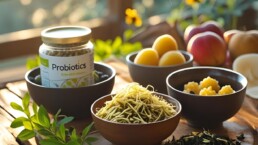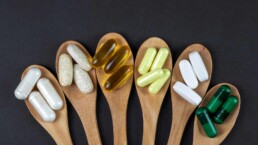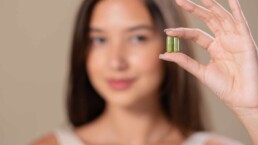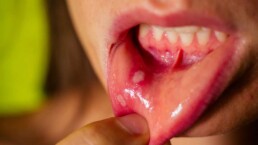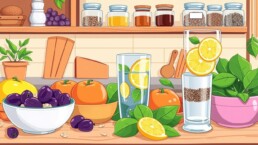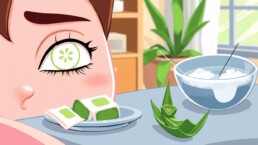Vitamin D3, also known as cholecalciferol, helps your health in many ways. It supports bone growth and fights off sickness. Yet, lots of folks in India lack this vital nutrient from their food and the sun. This piece will show you the best ways to get more vitamin D3 naturally.
Table of Contents
ToggleStudies say 35% of adults in the US don’t get enough vitamin D. In places like Pakistan, India, and Bangladesh, it’s likely worse. You should aim for 800 IU of vitamin D a day. This is 20 mcg. But, eating enough D-rich foods can be hard. The good news is, there are tasty options that are strong in vitamin D3. They can lift your health and mood.
What Is Vitamin D3?
Vitamin D3 is a key vitamin made from sunlight. Our skin turns cholesterol into D3 when the sun shines on us. This type helps our bodies more than D2, which comes from plants.
A blood test measures how much D we have. It’s called 25(OH)D. If you have over 50 nmol/L, you’re doing good. But too much, over 125 nmol/L, might not be great.
You can get vitamin D from food and pills, in D2 or D3. Doctors like to see your 25(OH)D over 75 nmol/L to keep your bones strong. Eating 600 IU a day is enough for most adults. But no need to go over 4,000 IU daily.
Benefits of Vitamin D3
Vitamin D3 is very important for your health. It helps keep your bones strong. It also helps your immune system work right. Let’s look closer at how this vitamin helps us.
Supports Calcium Absorption and Bone Health
Vitamin D3 helps your body use calcium. Calcium makes your bones strong. It stops bone loss and lowers the chance of osteoporosis. So, get enough vitamin D3 for your bones.
Strengthens the Immune System
Vitamin D3 is key for your immune system. It helps fight sickness. Having enough vitamin D3 can protect against some diseases. This includes diseases like multiple sclerosis.
Supports Growth and Development
Infants and kids need vitamin D3 a lot. It helps their bones and teeth grow right. This makes them stronger and smarter. So, vitamin D3 is crucial for growing up well.
May Promote Weight Loss and Improve Energy Levels
New studies show vitamin D3 might help you lose weight. It could make you more energetic too. These benefits are good for your health. Vitamin D3 is good for you in more ways than we knew.
So, vitamin D3 is great for bones, fighting illness, and maybe, health habits. Eat foods like fish, eggs, and milk to get enough. This will help you stay healthy. And it’s good for your life in many ways.

Problems Caused by Deficiency of Vitamin D3
Vitamin D3 is very important for our health. Not having enough can cause issues. Recent studies show many people lack this essential vitamin.
Weak Bones and Increased Fracture Risk
Vitamin D3 deficiency makes bones weak and easy to break. It helps the body absorb calcium, crucial for strong bones. Without it, bones may become brittle and break easily, leading to problems like osteoporosis.
Weakened Immune System
Vitamin D3 also helps keep our immune system strong. Not getting enough can increase the risk of getting sick. This includes anything from the common cold to more serious infections like pneumonia and COVID-19.
Slow Wound Healing and Fatigue
Low vitamin D3 levels can slow down wound healing. It causes more fatigue and tiredness than usual. This means your body takes longer to get better from injuries.
If you feel tired all the time or your wounds heal slowly, you should see a doctor. They can check if you lack vitamin D3. You may need to change your diet or spend more time in the sun.
Fatty Fish: A Powerhouse of Vitamin D3
Fatty fish are top for vitamin D3. Salmon, tuna, mackerel, and halibut are rich in this key vitamin.
A 3.5-ounce (100-gram) piece of farmed Atlantic salmon has 526 IU. It gives you 66% of the daily need. Wild-caught salmon has up to 924 IU per serving, which is more than 100%.
Tuna and mackerel are also big sources of vitamin D3. By eating just a bit, you can get enough vitamin D3 for the day.
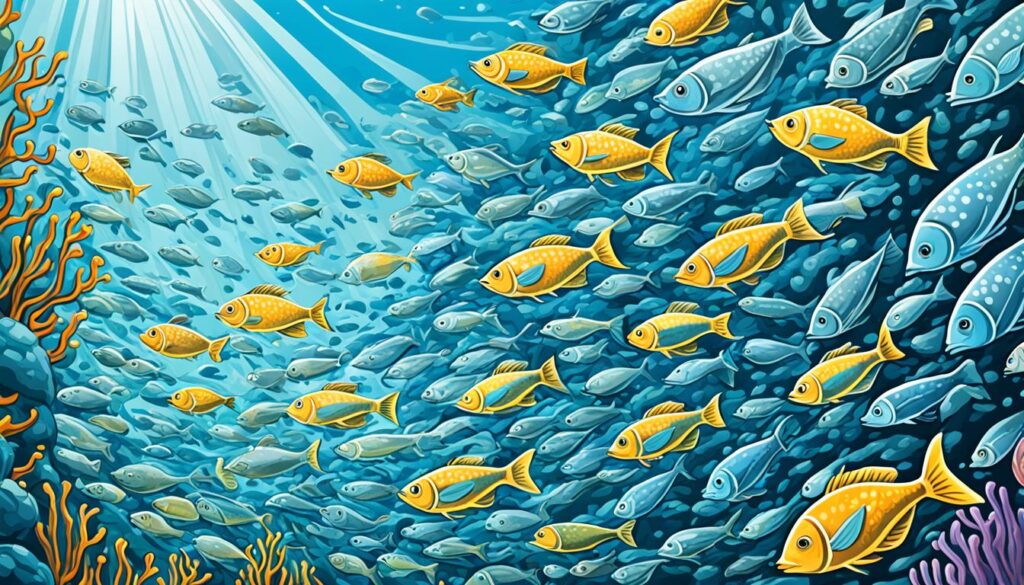
Add salmon and tuna to your meals for more vitamin D3. Grilling, baking, or putting them in salads makes them tasty and good for you.
Egg Yolks: A Surprising Source of Vitamin D3
Salmon and tuna are well-known for vitamin D3. Yet, egg yolks are a surprising hero. They’re rich in this key vitamin, adding value to your meals.
Each large egg yolk gives you about 37 IU of vitamin D3. This is 5% of what you should have daily. But, the actual D3 amount in eggs changes. It depends on the chicken’s sunshine time and their feed’s D3 levels.
If chickens are outside more or eat D3-rich food, their eggs have more vitamin D3. Research shows egg yolks can have between 37 IU to a huge 34,815 IU per 100 grams. This range is because of what the chickens eat and where they live.
Looking for a natural way to get more vitamin D3? Consider egg yolks. They are great boiled, fried, or mixed into food. So, add them regularly to your meals for a D3 boost.
Mushrooms: The Plant-Based Vitamin D3 Food
When folks talk about where to get vitamin D3, they often mention things like fatty fish and egg yolks. But, there’s a plant-based surprise that’s worth noting: mushrooms. They are the only non-animal source of vitamin D3. That’s good news for people on a plant-based diet.
Mushrooms are like us in some ways. They can make vitamin D when they’re out in the sunlight. For example, some wild mushrooms called morels can give you up to 136 IU of vitamin D2 per cup. But, the mushrooms that are grown and then treated with UV light are even better. They can give you up to 1,110 IU of vitamin D2 per cup. That’s 139% of the daily amount you need!
So, why do UV light-treated mushrooms have so much vitamin D2? The UV light changes a compound in the mushrooms, ergosterol, into vitamin D2. This change makes the vitamin D2 easier for us to use.
Eating UV-treated mushrooms is a smart way to get more vitamin D3. You can cook them many ways, like sautéing or mixing them into your meals. They’re a top pick for raising your vitamin D3 levels naturally.
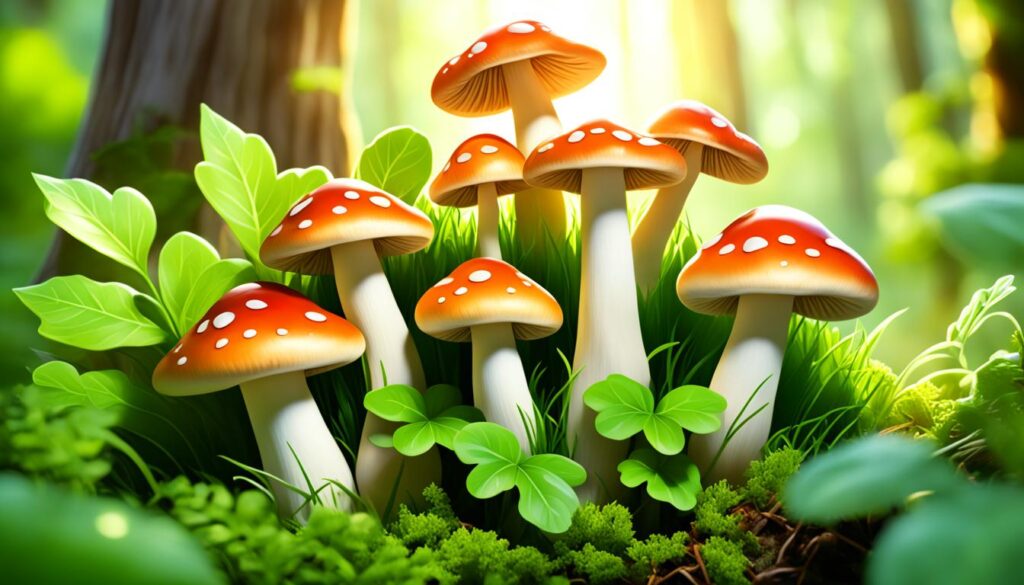
Mushrooms don’t just help with vitamin D3. They’re also full of good things like B vitamins, selenium, and anti-oxidants. This makes them a healthy and tasty choice to add to your meals. With UV-treated mushrooms, you’re doing something good for your health.
Fortified Foods: A Convenient Way to Get Vitamin D3
It’s hard to get enough vitamin D3 from natural sources. That’s why many foods are fortified with it. Cow’s milk, soy milk, and orange juice, along with some cereals, have extra vitamin D3. This makes it easier to get more of this important nutrient.
Vitamin D3 in Dairy and Plant-Based Milk
A cup of fortified cow’s milk has about 115 IU of vitamin D3. Fortified soy milk or orange juice adds 100-119 IU. This is 13-15% of what you need daily. Using these foods ensures you’re getting the vitamin D3 you need.
Fortified Cereals: A Vitamin D3 Boost
Some breakfast cereals are also fortified with vitamin D3. They have about 40 IU in each serving. Raisin Bran can have as much as 60.2 IU per cup. Adding these cereals to your meals helps you reach your vitamin D3 goals.
The amount of vitamin D3 you need each day changes with age. For most adults, it’s between 400 to 800 IU. Eating fortified foods regularly is a smart way to make sure you get enough. This is especially true if you can’t get as much from natural sources.
Vitamin D3 Food: Boost Your Levels Naturally
Keeping your vitamin D3 levels up is super important for staying healthy. Luckily, there are many tasty foods that can help. By eating foods rich in vitamin D3, you can make sure your body gets enough of this key nutrient.
Fatty fish like salmon, tuna, and mackerel are great for vitamin D3. For example, a serving of farmed salmon has about 526 IU. This is 66% of what you need in a day.
Don’t forget about egg yolks. One large egg yolk gives you 37 IU, which is 5% of your daily value. Adding egg yolks to your diet is easy and tasty.
Mushrooms are a plant-based surprise for vitamin D3. Regular mushrooms give you about 136 IU per cup. If they’re treated with UV, this amount can go up to 1,110 IU.
For added vitamin D3, try fortified foods. Things like cow’s milk, soy milk, orange juice, and cereals are often fortified. They help boost your vitamin D3 levels each day.
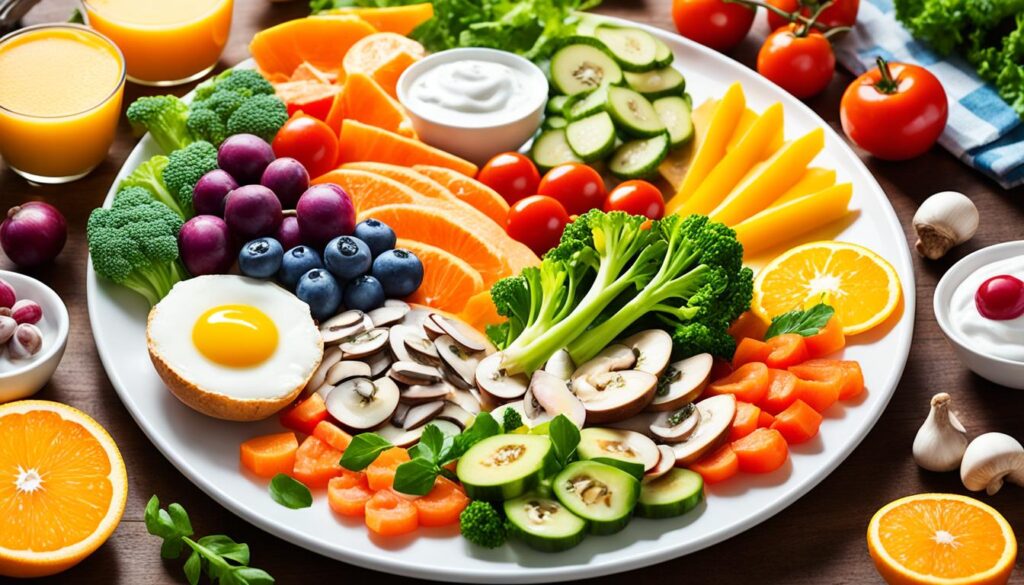
By adding these foods to your meals, you can meet your vitamin D3 needs. Whether you love fatty fish, egg yolks, mushrooms, or fortified foods, there are many ways to get your vitamin D. So, go ahead and enjoy.
Cod Liver Oil: A Concentrated Source of Vitamin D3
Vitamin D3 is super important for staying healthy. Cod liver oil is a top choice for getting vitamin D3. In just one teaspoon, it has about 56% of what you need each day.
Cod liver oil is great for fighting vitamin D shortage. A study in the Journal of the American College says a teaspoon has about 450 IU of vitamin D3. It’s a big help for your health.
Besides vitamin D, cod liver oil gives you vitamin A and omega-3s. These help your body in many ways. But, remember, too much vitamin A is not good for you.
Adding cod liver oil to your meals is a smart way to get more vitamin D3. You can take it straight or mix it in your dishes. This choice gives you lots of benefits.
Canned Tuna: A Convenient Option
Looking for a quick way to get tuna vitamin D3? Canned tuna is a smart pick. A 3.5-ounce serving has about 269 IU of tuna vitamin D3.
Remember, big tuna types might have more mercury. So, go for canned light tuna vitamin D3 content to be safer.
Canned tuna is handy and can fit with lots of meals. Eat it by itself, in salads, or on top of other foods. It’s a simple way to get more vitamin D3 every day, no matter where you are.
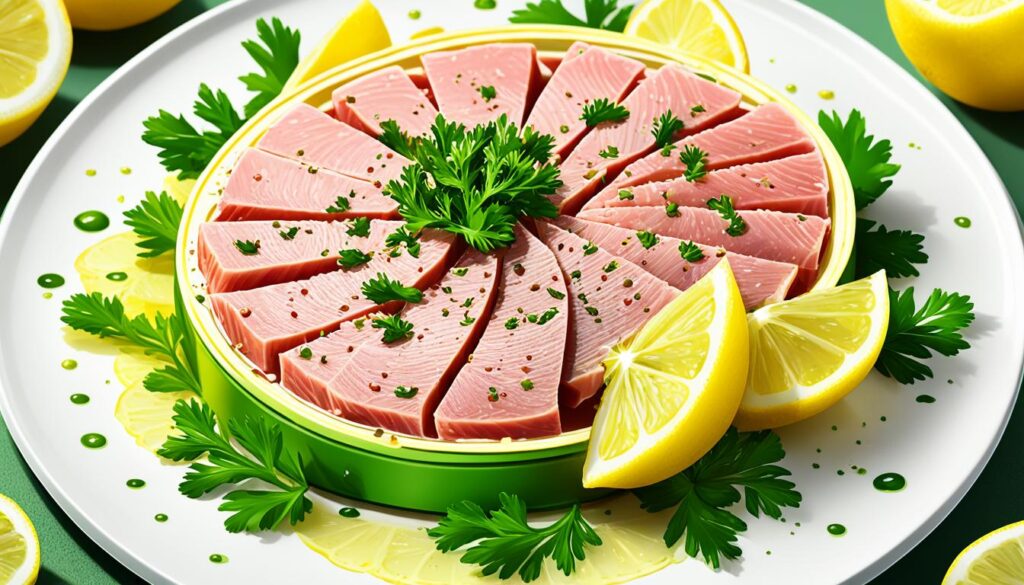
Vegetarian Vitamin D3 Food Recipes
Being vegetarian or vegan might make getting enough vitamin D3 hard. But, many tasty recipes help out. Creamy soups and yummy bowls are packed with vegetarian vitamin d3 recipes. They can boost your D3 and keep you healthy.
Carrot Ginger Soup with Vitamin D-Fortified Yogurt
This Carrot Ginger Soup is comforting, especially on cold days. Adding vitamin D-fortified yogurt in it boosts each serving with up to 120 IU of vitamin D3. The mix of beta-carotene in carrots and ginger plus the yogurt makes it a great vegetarian vitamin d3 recipe.
Kale and Quinoa Bowl with Mushrooms and Vitamin D-Fortified Olive Oil
The Kale and Quinoa Bowl is full of good stuff. It includes plant based vitamin d3 sources like mushrooms and vitamin D-fortified olive oil. UV light exposed mushrooms are rich in vitamin D3, with 1,136 IU in about 3.5 ounces. This dish is not only tasty but also a great vegetarian option to up your D3.
Vegetarian Frittata with Egg Yolks and Cheese
Egg yolks and cheese are right on target for vegetarian frittata. A big egg yolk has up to 39 IU of vitamin D3. Cheeses like fontina, Monterey, and cheddar add more. This frittata is great for any meal and also good for adding vitamin D3 to your diet.
By adding these recipes to your meals, you can make sure you get enough vitamin D3 each day. It’s good for your health and well-being.
The Sunshine Vitamin: Getting Vitamin D3 from Sunlight
Vitamin D3 comes from food and the sun. Our skin makes it when we’re in sunlight. Yet, making enough D3 from the sun can be hard for some. Things like skin color, where you live, the time of day, and using sunscreen matter.
Studies show many folks in the U.S. lack vitamin D. Getting enough sun is key to fixing this. Even just 13 minutes of midday sun three times a week in summer can help. This was proven good enough for folks in the UK.
But, in places like Boston or Edmonton, the sun doesn’t help much in winter. The same problem happens in Norway from October to March. So, eating foods rich in vitamin D3 is very important for them.
Sunscreen is great for the skin but affects vitamin D3 making. An SPF of 30 can lower D3 making by lots. Plus, sunscreen may stop working after two to three hours in the sun.
While the sun is good for us, there’s a need for balance. Where you are, your skin, and how much sun you get are important. Knowing how to get the right amount of sun helps keep you healthy.
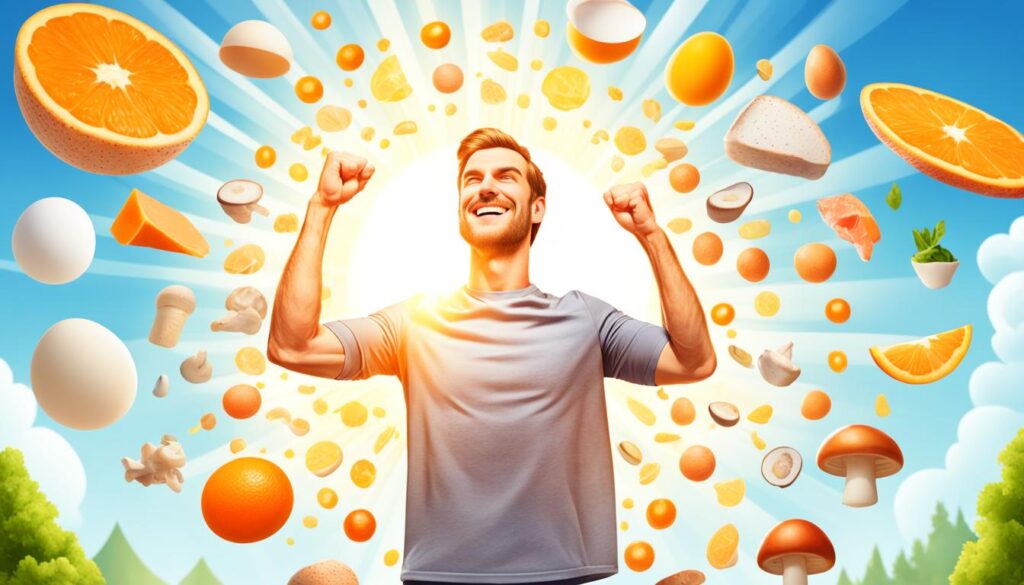
Vitamin D3 Supplements: When Diet Isn’t Enough
Getting vitamin D3 supplements from food is best. But it’s hard for some to get enough from diet alone. This is true if they see little sun or eat no animal products. For these folks, taking vitamin D3 supplements might be a good choice.
Always talk to a doctor before taking vitamin D3 supplements. They will help figure out if you need them and how much. Lack of vitamin D can be bad for kids. It might cause rickets and dental issues.
The AAAAI says low vitamin D can up the chance of allergies. Being short on vitamin D for a long time can soften your bones. This might cause many health problems.
Babies up to 12 months should have 400 IU of vitamin D every day. Adults can take up to 4,000 IU daily. For most adults, 600 IU a day is good.
But, too much vitamin D isn’t good either. It might make you very sick. Always check with a doctor before you start taking vitamin D3 supplements.
Conclusion
Vitamin D3 is key for your health. It’s in foods like fatty fish and egg yolks. Also, the sun gives us vitamin D.
Vitamin D3 keeps our bones and immune system strong. Including it in daily meals is smart. Start today and feel better because of it.
Love vitamin D3-rich foods for a healthy life. Here’s to feeling better and brighter every day!
FAQ
What is vitamin D3?
Vitamin D3 is known as cholecalciferol. It’s made in our bodies from cholesterol. It’s a key type of vitamin D, found along with vitamin D2 in nature.
What are the benefits of vitamin D3?
Vitamin D3 helps the body absorb calcium and keeps our bones strong. It also boosts the immune system. Plus, it helps with growth and may aid in weight loss. It can help you sleep better and give you more energy.
What can happen if you have a deficiency of vitamin D3?
Not getting enough vitamin D3 can cause problems. It can make your bones weak and put you at a higher risk for infections. Slow wound healing and feeling tired are also signs of deficiency.
What are some good food sources of vitamin D3?
Fatty fish like salmon, tuna, and mackerel are great sources of vitamin D3. So are egg yolks and mushrooms. Foods like milk, plant-based milks, and orange juice that are fortified also have vitamin D3.
How does the body produce vitamin D3 from sunlight?
Our skin makes vitamin D3 when the sun’s UVB rays hit it. But, things like how dark your skin is, where you live, the time of day, and using sunscreen change how well your body makes vitamin D3.
When might vitamin D3 supplements be necessary?
Some folks need vitamin D3 supplements because sunlight and food aren’t enough. Talking to a doctor can help figure out if you need them. They can also help you find the right amount to take.
Source Links

This article is medically reviewed by Dr. Chandril Chugh, Board-Certified Neurologist, providing expert insights and reliable health information.
Dr. Chandril Chugh is a U.S.-trained neurologist with over a decade of experience. Known for his compassionate care, he specializes in treating neurological conditions such as migraines, epilepsy, and Parkinson’s disease. Dr. Chugh is highly regarded for his patient-centered approach and dedication to providing personalized care.

